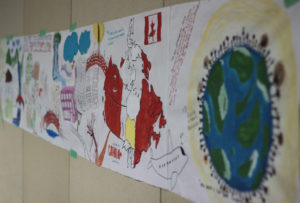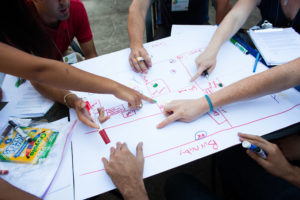National Spiritual Assembly contribution to 2016 National Convention: “In the throes of learning”
The following is a contribution the National Spiritual Assembly made to this year’s National Convention, which it felt would be of interest to all the friends. It highlights advances made and insights gained by the Canadian Bahá’í Community over the last 20 years, since the start of this series of Plans.

The first training institute campaign in Toronto, Ont. in 1997. The courses used at the time focused on the fundamental verities of the Faith.
The Canadian Bahá’í community entered the Four Year Plan in 1996 with resolve and vigour. In the first year of the Plan, six training institutes were established, one in each region of the country, and by the spring of 1997 the first training courses, focused on the fundamental verities of the Faith, were being offered.
At the International Convention in 1998, the National Assembly noted the encouraging progress being made in areas of the world using the materials of the Ruhi Institute, and in 1999 called for these materials “to be at the core of Canada’s institute process for the foreseeable future.” This decision provided the nascent institutes with welcome clarity and their attention turned to learning about the curriculum and raising tutors. To support the efforts of the institutes, a special gathering was held in Montreal in May 2000 with the assistance of Counsellors and experienced friends from South America to learn more about the approach and materials of the Ruhi Institute. Among the friends present, there were about 200 tutors, among whom was only one youth. From the insights and encouragement gained at this gathering, the training institutes set numerical goals for training tutors and establishing study circles.
With this greater clarity came increased focus and by the start of the One Year Plan in 2000, the institutes established a rhythm of training; the number of tutors and study circles began to steadily rise. During the brief and critical One Year Plan, the institutes established the first, simple schemes of coordination, most commonly consisting of a few “area coordinators” that helped organize tutor training and lent support to tutors as they began study circles. By the end of the One Year Plan, over 2,000 people in Canada had completed at least one institute course, with hundreds moving on to the study of subsequent courses—a pyramid of human resources was filling out.
A persistent question was how to help these devoted friends serve effectively. The introduction in 2001 of the concepts of clusters and core activities was invaluable. These activities, each building on the learning and achievements of the previous Plan, helped channel human resources to strengthen patterns of growth in small geographic areas in which the friends could read their reality, plan, and collaborate for the progress of the Cause. Working to help some 50 people complete the full sequence of courses in a number of clusters in each region, the training institutes gained a great deal of experience with the first few courses of the curriculum and began to more systematically incorporate the practice components of the courses. As a result, more and more friends across the country achieved a deeper understanding of the nature of teaching the Faith and their practical ability to share the Word of God with others increased. More and more invitations were being extended to friends of the Faith—family, neighbors, co-workers, and others—to join core activities. These activities became centres of unity, and points of attraction, not only for members of the Bahá’í community, but gradually for more and more of their friends.
In September 2002, the Vancouver-UBC cluster achieved the conditions necessary to accelerate the work of expansion and consolidation, establishing the first intensive programme of growth in North America: “the systems the Plan requires are in place; the friends can now proceed with full confidence to welcome a steadily rising number of their friends, neighbors, relatives and co-workers into the core activities and fireside gatherings.” Throughout 2004 and 2005 additional clusters established propitious conditions and began intensive programmes of growth, largely the result of efforts to help 50 or so individuals complete the full sequence of courses. All in all, Canada concluded the Plan at Ridván 2006 with 17 intensive programmes of growth. Across the country there were well over 1,000 core activities with more than 7,000 participants, nearly 20 percent of whom were from the wider community.
The Canadian Bahá’í community thus entered the Five Year Plan at Ridván 2006 on a firm foundation. Efforts of the previous Plans had begun to give rise to a new culture, a culture characterized by teaching and learning. The community was abandoning any last traces of a congregational mindset and a renewed confidence emerged that the peoples of the world were indeed receptive. The goal to raise the number of intensive programmes of growth from 17 to 46 strengthened the resolve of the friends and institutions to labour unceasingly to bring the Word of God to the peoples of Canada and to contribute to a new culture, to an advancing civilization.
Institutes had been making efforts to engage junior youth since the One Year Plan. Their efforts, while small, had confirmed that this age group is eager to engage in meaningful conversation about profound themes and to serve; there were many positive stories of junior youth thriving in the environment of a junior youth group. In the summer of 2005, a group of youth in Ottawa reached out to junior youth in a small neighborhood and were able to form a group with some 20 participants, all from the wider community. This initiative and the study of the guidance led the institutes at the start of this second Five Year Plan to launch systematic efforts to raise animators and begin junior youth groups, setting the community on a path of learning in action that would yield some of the finest fruits of this series of Plans. The response of junior youth and children to these efforts was greater than what was ever imagined by these young people during their training.

A banner created by youth at the youth conference held in Toronto, Ont. in July 2013, among the first 114 conferences across the world called for by the Universal House of Justice.
Engaging junior youth led the institutes to think about neighborhoods, small geographic areas where people could walk to activities, and where the Faith could become known as a source of moral and spiritual excellence. In these small settings, where families live and people naturally interact, pursuit of a two-fold purpose would contribute in time to a change in culture. In the first few years of the Plan, junior youth groups were formed in dozens of neighborhoods in clusters that were working to establish intensive programmes of growth.
As this second Five Year Plan opened, the training institutes began gaining more experience in helping participants study the higher level courses in the sequence, and this led naturally to consultation about how to help these friends teach directly and participate in teaching projects. At the same time, those working with junior youth in neighborhoods began to realize that for the junior youth programme to root more deeply and grow further, residents needed to learn more about Bahá’u’lláh and His Faith. This launched the community into learning about direct teaching, and collective teaching projects. Hundreds of teaching projects were held in cluster after cluster across the country in which hundreds upon hundreds of friends sought to engage those in the wider community—family, neighbours, co-workers and many who lived in particular neighborhoods. In the span of a few cycles, capacity to teach collectively began to rise—the friends began to think about teaching not just individuals, but families, and groups of friends; consciousness of the movement of populations was increasing. These years hold some of the most precious and moving memories of this series of Plans.
These efforts gave rise to tremendous learning and capacity. The response of people from all walks of life to the Message convinced the friends and institutions that the peoples of Canada are receptive, despite preconceptions that this was an insular, secular society in which people were not willing to talk about spiritual matters and religion. All witnessed the tremendous receptivity, particularly of young people, and the unifying effect core activities had at the level of a neighborhood or in a network. The efforts strengthened the learning process as the friends and agencies strove to become more effective at teaching and community building—these efforts strengthened the community’s commitment to learning in action. Action, reflection and consultation became more woven into the pattern of individual and collective action. We learned how to go beyond making presentations to engaging people in a meaningful and distinctive conversation, a conversation born out of love and carried on with humility and caring. The institutes gained greater insight into the dynamics of training and accompanying friends into the field of service. The community became more aware, more nurturing. Teaching became natural.

A group of youth at the Vancouver youth conference in 2013 map out their community to help them make plants to bolster its material and spiritual development.
Such were the achievements of this Plan. A new culture that took root in the initial Plans began to give beautiful fruits. In the course of the Plan, some 800 core activities were established, the number of participants nearly doubled—and now, nearly one-third were from the wider community. And, the goal of the Plan—which seemed so daunting at the start—was surpassed.
The Canadian Bahá’í community entered the third Five Year Plan having established 49 intensive programmes of growth and immediately began to build on these accomplishments—to strengthen further these 49 and bring the insights to another 58 clusters.
Over the past 5 years, in cluster after cluster, in every kind of social environment in the country—from the south to the far north, from the east to the west—small yet coherent programmes of growth began to emerge as the learning process strengthened. At the same time, clusters with intensive programmes of growth strengthened the pattern of action further, drawing more people into core activities and enriching the culture of learning that had taken root in the previous Plan.
Two strategies helped the community achieve the aims of the Plan: first, waves of homefront pioneers and travelling teachers—many of them youth—travelled to clusters, settled in neighborhoods, and began working to reach the first milestone; and second, strengthening a movement of youth. These friends, bolstered by the constant encouragement and support of the Auxiliary Board members and their assistants, helped the friends increase the number of programmes of growth to 108—a programme has now been established in over 90 percent of clusters across the country.
The receptivity of junior youth to the spiritual empowerment programme has never been an obstacle to its growth; the limit has been the number of trained animators. This realization led to sustained efforts to reach youth in cluster after cluster, to engage them in a meaningful and distinctive conversation and assist them to walk a path of service to their communities, ideally as animators. The youth conferences, held just after the mid-point of the Plan, drew thousands of youth together in a common pursuit. The institutes began learning about how to help contingents of youth to enter the institute process and complete book after book—building their capacity to contribute to an advancing civilization. By the end of the Plan, nearly 5,000 youth in Canada were engaged in this movement to some degree. All of these efforts led to a doubling of the number of junior youth participating in a group.
As we gather at the Convention this weekend and embark on the next stage in the unfoldment of the Divine Plan, we reflect on the manifold evidences in the increase in capacity of each of the three protagonists of civilization.
In these youth who have responded to His call we get a glimpse of a new individual, an individual walking, in the company of others, a path of service to the community with humility and love; an individual learning with others how to navigate past the pitfalls of an increasingly materialistic world, to live life more coherently, and to contribute to a spiritual and prosperous civilization.
In these neighborhoods we have a glimmer of a new community, a community that prays together, that is aware of the presence of the sacred, conscious of the need to nurture the younger generations, that seeks to draw those who are excluded into the circle of friendship, that reflects and consults together about its future—a community learning to speak with one voice and work together as the fingers of one hand.
And supporting all of these achievements we see a new kind of institution emerging, institutions that collaborate together, that are concerned and work for the welfare of each and all, institutions learning to nurture human capacity and channel it for the betterment of the world.
Category: Institutions, National Spiritual Assembly









